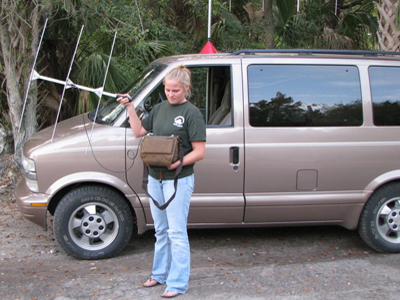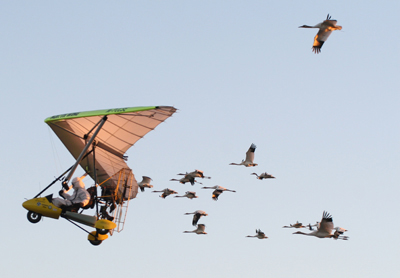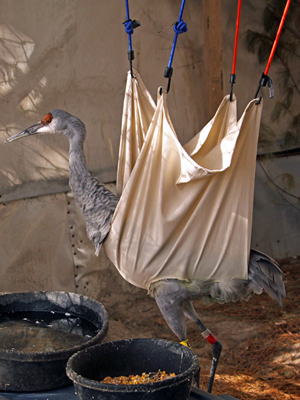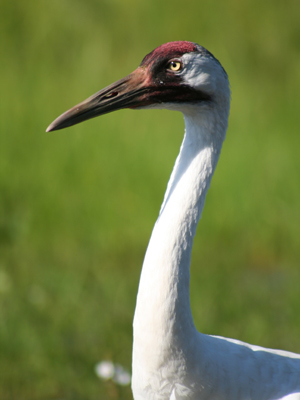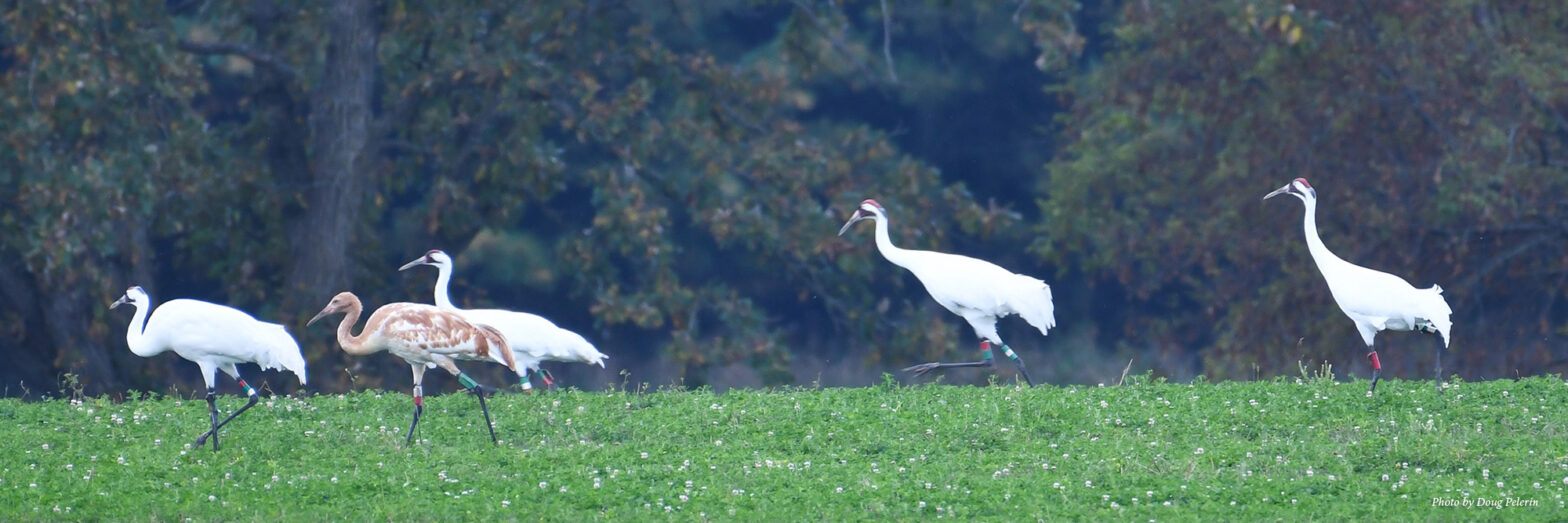![]() ICF’s Eva Szyszkoski, Tracking Field Manager for the Whooping Crane Eastern Partnership (WCEP), has been in Alabama banding the group of nine ultralight-led Whooping Cranes, which were released at Wheeler National Wildlife Refuge earlier this month. Last week, Eva was tracking a tenth Whooping Crane (#2-11), who had separated from the other nine juvenile cranes during migration in Wisconsin last October and wintered in Florida. Following is Eva’s report on her attempt to re-capture #2-11 to replace it’s radio transmitter (and news that spring migration has started!).
ICF’s Eva Szyszkoski, Tracking Field Manager for the Whooping Crane Eastern Partnership (WCEP), has been in Alabama banding the group of nine ultralight-led Whooping Cranes, which were released at Wheeler National Wildlife Refuge earlier this month. Last week, Eva was tracking a tenth Whooping Crane (#2-11), who had separated from the other nine juvenile cranes during migration in Wisconsin last October and wintered in Florida. Following is Eva’s report on her attempt to re-capture #2-11 to replace it’s radio transmitter (and news that spring migration has started!).
Results for "Headlines Videos cleantalkorg2.ru Share Market breaking newstoday Read Breaking News Today World News breaking news english search world news"
Ultralight-led Whooping Cranes will be Released on Wheeler NWR
 Nine juvenile Whooping Cranes on their first ultralight-led migration south will be taken to Wheeler National Wildlife Refuge (NWR) in Morgan County, Ala. in the next few days. The nine Whooping Cranes will be placed in travel enclosures and loaded onto vehicles as soon as possible. They will be driven about 70 miles from Winston County, Ala., to Wheeler NWR. The cranes will be temporarily housed in a secure pen, during which time they will be fitted with identification bands and tracking transmitters. The young birds will then be released in the company of other Whooping Cranes that have been wintering at the refuge.
Nine juvenile Whooping Cranes on their first ultralight-led migration south will be taken to Wheeler National Wildlife Refuge (NWR) in Morgan County, Ala. in the next few days. The nine Whooping Cranes will be placed in travel enclosures and loaded onto vehicles as soon as possible. They will be driven about 70 miles from Winston County, Ala., to Wheeler NWR. The cranes will be temporarily housed in a secure pen, during which time they will be fitted with identification bands and tracking transmitters. The young birds will then be released in the company of other Whooping Cranes that have been wintering at the refuge.
Aransas Refuge Reports on Whooping Crane Status in Texas
 This has been a busy month for Whooping Crane activity since our last report. Aransas National Wildlife Refuge has received an additional 0.72 inches of precipitation and salinity levels remain higher than ideal. We have continued to help alleviate the low food resources by adding to our prescribed burn totals. This week alone we have burned an additional 4,682 acres of Whooping Crane habitat. Biologists observed the Whooping Cranes eating roasted acorns and are seeing continued usage.
This has been a busy month for Whooping Crane activity since our last report. Aransas National Wildlife Refuge has received an additional 0.72 inches of precipitation and salinity levels remain higher than ideal. We have continued to help alleviate the low food resources by adding to our prescribed burn totals. This week alone we have burned an additional 4,682 acres of Whooping Crane habitat. Biologists observed the Whooping Cranes eating roasted acorns and are seeing continued usage.
A Helping Hand
 At ICF’s Baraboo headquarters, we have all 15 species of crane, many for purposes of breeding and maintaining the valuable genetic lines of several endangered species. That responsibility, however, precludes us from taking in any injured cranes, either from public reports or as a result of our research. Wild birds have the potential of bringing with them any number of diseases that could wreak havoc with our captive population; that is a risk we cannot take.
At ICF’s Baraboo headquarters, we have all 15 species of crane, many for purposes of breeding and maintaining the valuable genetic lines of several endangered species. That responsibility, however, precludes us from taking in any injured cranes, either from public reports or as a result of our research. Wild birds have the potential of bringing with them any number of diseases that could wreak havoc with our captive population; that is a risk we cannot take.
Wildlife Agency Urges Crane Spectators to Maintain Distance
 As a pair of Whooping Cranes remains in North Carolina’s Clay County, the U.S. Fish & Wildlife Service urges spectators to maintain their distance in order to not spook the cranes and reduce their familiarity with humans.
As a pair of Whooping Cranes remains in North Carolina’s Clay County, the U.S. Fish & Wildlife Service urges spectators to maintain their distance in order to not spook the cranes and reduce their familiarity with humans.
“These cranes are among the rarest animals on the planet. In our efforts to recover this species, I can’t stress enough how important it is for people to give the birds the space they need to feel comfortable and go peacefully about their daily lives of finding food, water, shelter, and developing the bond that will lead to successful nesting in the spring,” said Bill Brooks, a biologist with the U.S. Fish & Wildlife Service.
Whooping Crane Shot in Indiana
 The International Crane Foundation (ICF) is saddened to learn of the shooting of male Whooping Crane #6-05 from the eastern migratory population. Number 6-05 was found dead on December 30 near Crothersville, Indiana. He was paired with DAR (Direct Autumn Release) Whooping Crane #37-09. Number 6-05 is the eighth Whooping Crane to be senselessly shot in the past year (two were shot in the non-migratory population in Louisiana and six in the eastern migratory population).
The International Crane Foundation (ICF) is saddened to learn of the shooting of male Whooping Crane #6-05 from the eastern migratory population. Number 6-05 was found dead on December 30 near Crothersville, Indiana. He was paired with DAR (Direct Autumn Release) Whooping Crane #37-09. Number 6-05 is the eighth Whooping Crane to be senselessly shot in the past year (two were shot in the non-migratory population in Louisiana and six in the eastern migratory population).
Group Tours
Group tours offered from May to October target all ages, from mixed youth and adult family groups to seniors. Our education department, staff and volunteers would be delighted to share… Continue reading Group Tours
School Field Trips
School field trips include fun, age-appropriate activities designed to engage students and their teachers. Our education department, staff and volunteers, would be delighted to share the stories of the world’s… Continue reading School Field Trips
Dr. Rich Beilfuss, President & CEO
Dr. Rich Beilfuss has served as the International Crane Foundation’s President & CEO and ex officio member of the Board of Directors since 2010. He helped launch many of the Foundation’s signature projects and provides oversight, vision and prioritization to… Continue reading Dr. Rich Beilfuss, President & CEO
North America
Issue The once threatened Sandhill Crane has made an inspiring comeback throughout much of its range. However, despite this success, the species continues to be threatened by power line collisions… Continue reading North America

